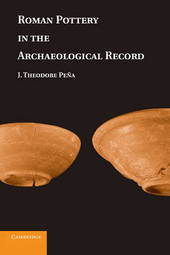
|
Roman Pottery in the Archaeological Record
Paperback / softback
Main Details
| Title |
Roman Pottery in the Archaeological Record
|
| Authors and Contributors |
By (author) J. Theodore Pena
|
| Physical Properties |
| Format:Paperback / softback | | Pages:450 | | Dimensions(mm): Height 229,Width 152 |
|
| Category/Genre | Classical Greek and Roman archaeology
Pottery, ceramics and glass crafts |
|---|
| ISBN/Barcode |
9780521181853
|
| Classifications | Dewey:937 |
|---|
| Audience | | Professional & Vocational | |
|---|
| Illustrations |
12 Tables, unspecified; 9 Maps; 88 Halftones, unspecified; 32 Line drawings, unspecified
|
|
Publishing Details |
| Publisher |
Cambridge University Press
|
| Imprint |
Cambridge University Press
|
| Publication Date |
7 March 2011 |
| Publication Country |
United Kingdom
|
Description
This book examines how Romans used their pottery and the implications of these practices on the archaeological record. It is organized around a flow model for the life cycle of Roman pottery that includes a set of eight distinct practices: manufacture, distribution, prime use, reuse, maintenance, recycling, discard, reclamation. J. Theodore Pena evaluates how these practices operated, how they have shaped the archaeological record, and the implications of these processes on archaeological research through the examination of a wide array of archaeological, textual, representational and comparative ethnographic evidence. The result is a rich portrayal of the dynamic that shaped the archaeological record of the ancient Romans that will be of interest to archaeologists, ceramicists, and students of material culture.
Author Biography
J. Theodore Pena is a Professor of Classics at the University of California, Berkeley. A specialist in the archaeology of the Roman economy and ceramic analysis, he is the author of The Urban Economy in the Early Dominate: Pottery Evidence from the Palatine Hill and The Mobilization of State Olive Oil in Roman Africa: The Evidence of Late 4th Century Ostraca from Carthage.
Reviews'Pena's book is an essential study that needed to be carried out, and its author was ideally placed to undertake this task. ... we strongly recommend that Pena's rigourous work should become a component of the training of all field archaeologists and pottery specialists involved in the study of Roman sites.' Antiquity 'Pena establishes himself as a leading figure in the of roman archaeology with this book, which provides a theoretical map of the life of any excavated Roman pottery shred. It should be read wherever archaeology is taught and will be an important resource for students of Roman pottery, for whom the illustrations, appendices, and maps will be particularly helpful. Furthermore, the book sets a new intellectual level for the study of excavation pottery in Old World archaeology. His book belongs in the reference library, not just of every excavation director and pottery analyst on Roman sites, but also of any archaeologist working with a sophisticated urbanized by preindustrial culture.' American Journal of Archaeology 'The book will be stimulating reading to classical archaeologists who work with excavated pottery, particularly from urban and domestic sites.' Bryn Mawr Classical Review 'By encouraging us to look more carefully at the behaviour that lies behind assemblage formation, the book has been entirely successful in its aims.' Journal of Roman Archaeology 'Usefully draws on a wide range of literary and pictorial sources to elicit information on poetry use ... this book should spur researchers to look more closely at their assemblages.' Current Archaeology
|